There are two families, each called Mylius, who may or may not be related, each of whom made a connection to the families described on this website.
The first Mylius connection is through the marriage of Barbara Mylius (1578 – 1637) to Ortolph Fomann (1560 – 1634) whose sister Maria Fomann (1579 – 1637) was the grandmother of Georg Adam Struve. The family chart below describes this relationship. Furthermore, the son of the marriage between Barbara Mylius and Ortolph Fomann – Ortolph Fomann II – married as his first wife The Three Loeck Sister’s Nth great grandmother Margaretha (Horn) Hilliger after she became a widow when her first husband Oswald Hilliger died. Ortolph and Margaretha had no children and she died in 1622. Although Georg Mylius is not a relation of the Three Loeck Sisters he nonetheless had an interesting career which is briefly described below.
Georg Mylius enrolled at the University of Tübingen to study theology in 1566 and moved on to the University of Marburg and the University of Strasbourg.
After completing his studies, he returned to Augsburg in 1571 and took over his first preaching position there in 1572 as a deacon at the Church of the Holy Cross. In Augsburg, he was drawn into the denominational disputes that were the result of the increasing presence of the Jesuits. Mylius acted conspicuously with polemical sermons that gave him a certain anti-jesuitical reputation. In order to gain further qualifications, he returned to Tübingen in 1576, where he received his doctorate in theology. When he returned to Augsburg, he became a pastor at the Church of St. Anna and thus assumed the highest position of preacher in the city.


The already politically sensitive situation in Augsburg dramatically increased in the following years by the well-known calendar dispute. The causes of the dispute lay, on the one hand, in the legally questionable action taken by the Augsburg city council when the Gregorian calendar was introduced in 1583, and, on the other hand, in the mistrust of the majority Protestant citizens of the council itself, as it was disproportionately occupied by Catholics. This mistrust fueled, among others, Mylius, as some of his writings from the time testify.
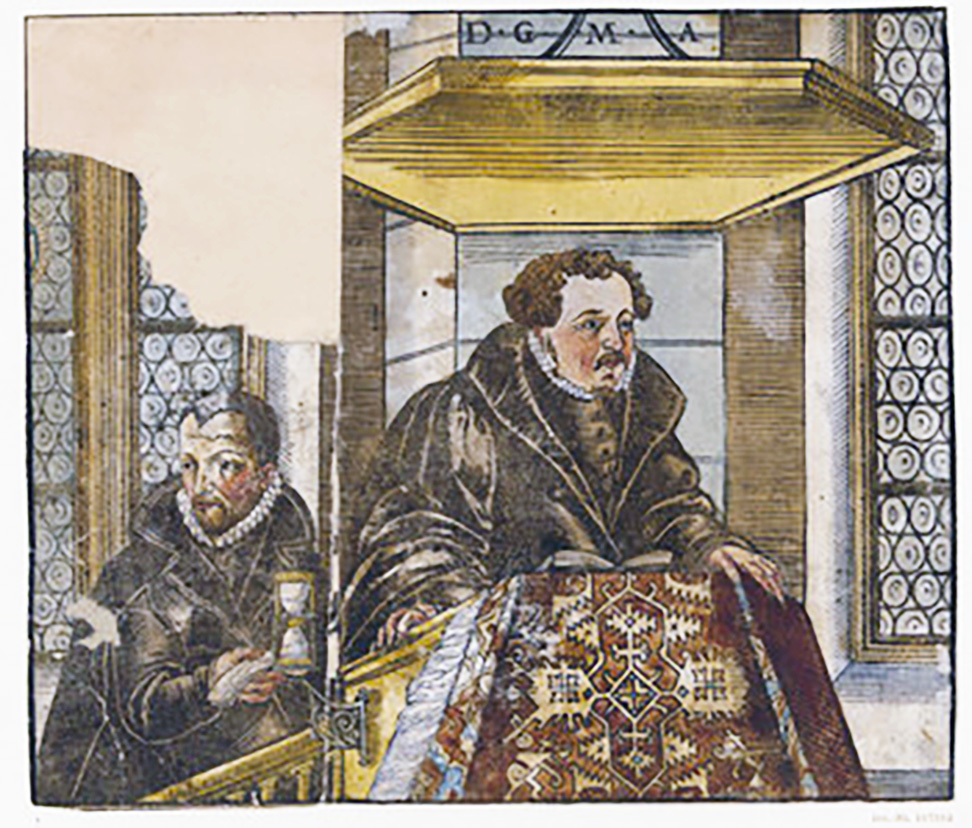
The dispute intensified on June 3, 1584 (according to the new calendar), which Protestants still counted as May 24. The day was a Sunday and the evangelical preachers announced that according to the old calendar, Ascension Day (despite the express prohibition of the city council) would be celebrated next Thursday. The next day, at lunchtime, the Augsburg mayor came to Mylius and read him a council resolution. He asked him to leave the city immediately in a carriage made available for this purpose. The dispute did not go unnoticed by the towns people, a large number of whom were Mylius’ supporters. They stormed the carriage just before the city gate and saved Mylius. At the same time, a more widespread uprising broke out in the city and was directed primarily against the Catholic councilors, who were now dependent on the mediation of the evangelical clergy. Mylius himself fled to Ulm on June 5, where he waited for his pregnant wife Barbara. But he did so in vain, because his wife had died as a result of a premature birth shortly after his arrest.

Mylius stayed with friends in Ulm for a year, remarried, and finally accepted a call to Wittenberg, where he became professor of theology on June 9, 1585. He became a preacher at the castle church and took over the office of chancellor from Johann Schütz at the university. However, he was unable to rest there because crypto-calvinists seized political power in Wittenberg and made the life of scholars such as Mylius increasingly difficult. Mylius left for Leucorea and on February 12, 1589 accepted a professorship in Jena. In 1601 he became a senior pastor and thus superintendent in Jena. In the autumn Mylius became the first professor of theology at the Leucorea, thus taking over the general superintendent of the Saxon spa districts and becoming a pastor at the city church of Wittenberg, which he occupied until his death.

A descendant of Georg’s by his second wife, Veronica Weiss, was Johann Anton Mylius whose two sons are shown below:
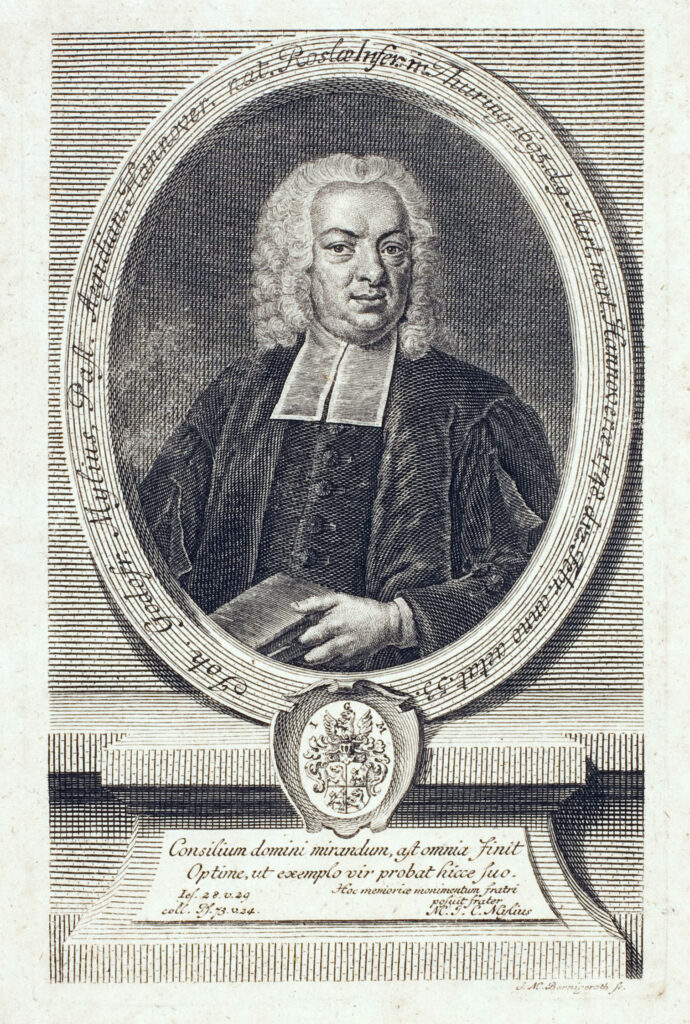
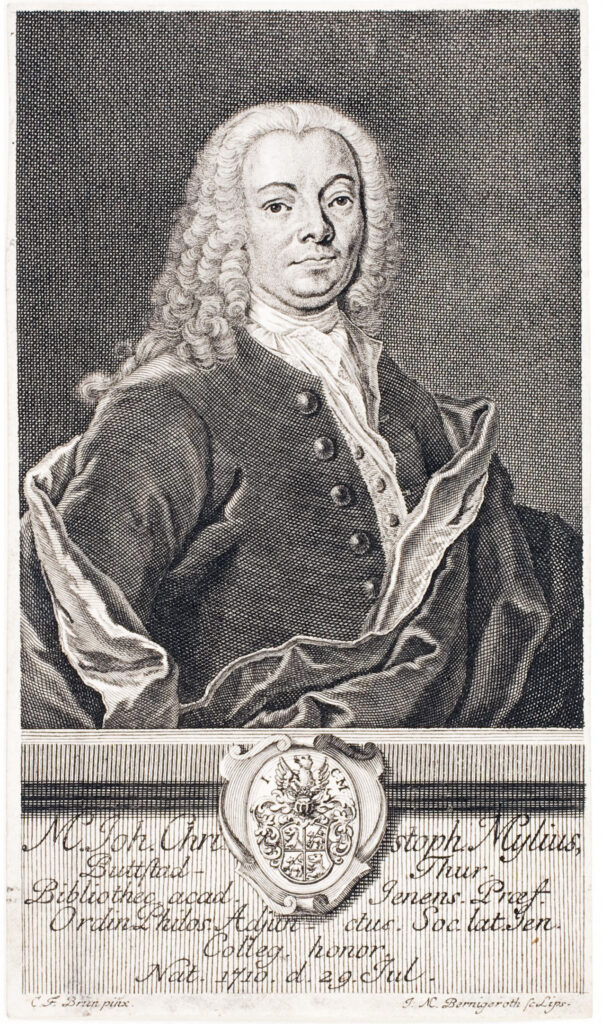
The second Mylius family connects that of the Three Loeck Sisters on the marriage of Christian Otto Mylius to Elizabeth Charlotte Bastineller. After her death in 1726, Otto then married her sister Christiane Rosine . These two Bastineller sisters were the granddaughters of The Three Loeck Sisters Nth great aunt Salome (Berlich) Freystein whose sister Susanna (Berlich) Struve is the Nth great grandmother of the Three Loeck Sisters.
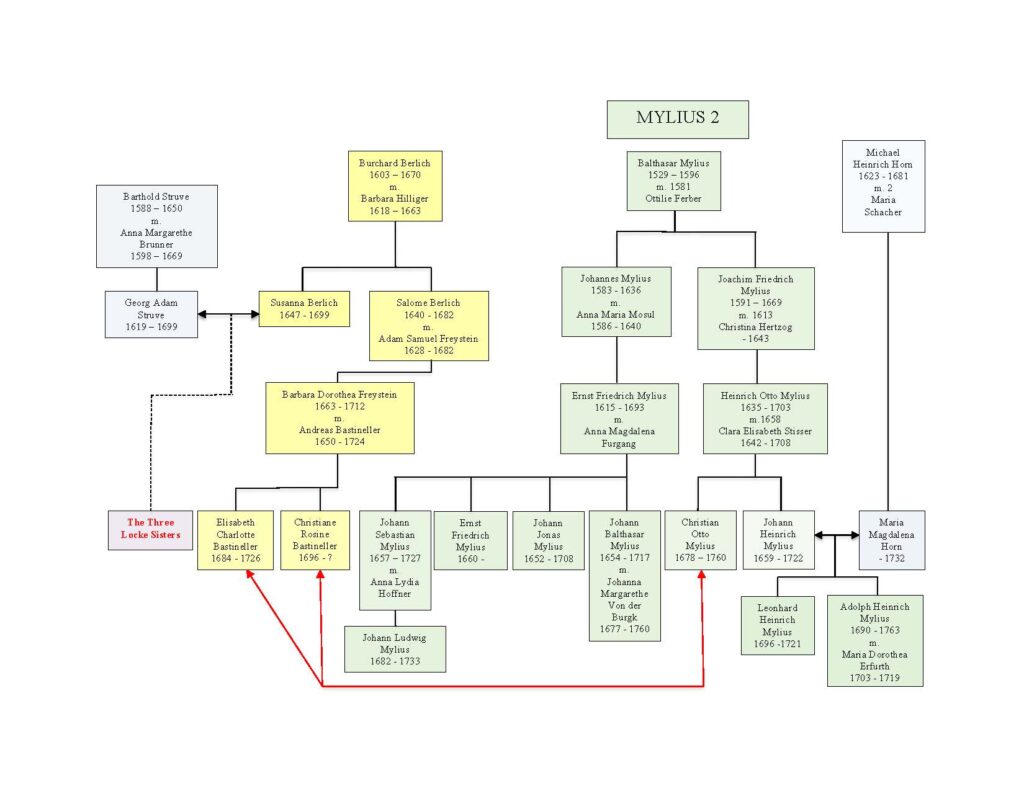
Christian Otto was born in Halle in 1678 as the last child of his parents seven children; his 19-year-older brother Johann Heinrich was already studying at Leipzig University. He spent his youth and childhood in Halle which, like those of his older brothers, were carefree. He was taught by private tutors and attended the grammar school in Halle.

Christian Otto’s great grandfather
The Allgemeine Deutsche Biographie paid tribute to the life of Christian Otto as follows:
“After Mylius had studied philosophy and law for a few semesters at the university in his hometown (Halle), he went to Leipzig in 1698 to continue his legal studies, where he obtained the baccalaureate in 1701. The next year he attained the highest academic dignity in Halle under Stryk’s chairmanship (doctorate in D. jur. Bd. Rights). There he married Elisabeth Charlotte on May 22, 1703, a daughter of the Prussian war commissioner and town hall master [Andreas Batineller] and after her childless death he wed her younger sister.

From 1703 Christian Otto held law lectures at the university and acted as administrator for the government and the consistory. Thanks to his official government position, he had access to the archive located in the town hall and used this opportunity to complete the collection of the edicts that had been issued since the unification of the Duchy of Magdeburg with Kurbrandenburg (namely the “Corpus constituionum Magdeburgicarum novissimarum”), which he had published in 1714.

(1659 – 1722)

Elisabeth Charlotte Bastineller
In 1716 he was elected councilor (mayor) and assessor for the Schöppenstuhle in Halle, but in the following year 1717 he was appointed as a war councilor to the military department and as a criminal councilor to the criminal college in Berlin, and he was also assigned the post of auditor to the gendarmes. He also only held these offices for a short time, as after a year (1718) he was promoted to deputy director of the War, Court and Criminal Court and in 1720 was summoned to the secret Council of Justice and the Higher Appeal Court. In 1723 we find him as Lieutenant General Auditor and in 1739 in the high and important post of Auditor General, after he had turned down the position of Supreme Court Director in the previous year (1738). Despite his advanced years, he was still mentally and physically fit enough that he held that post in high regard until he was 82 years old, in which he was highly respected. He died on January 11, 1760 after 57 years of service.
Below, two of Christian Otto’s cousins:
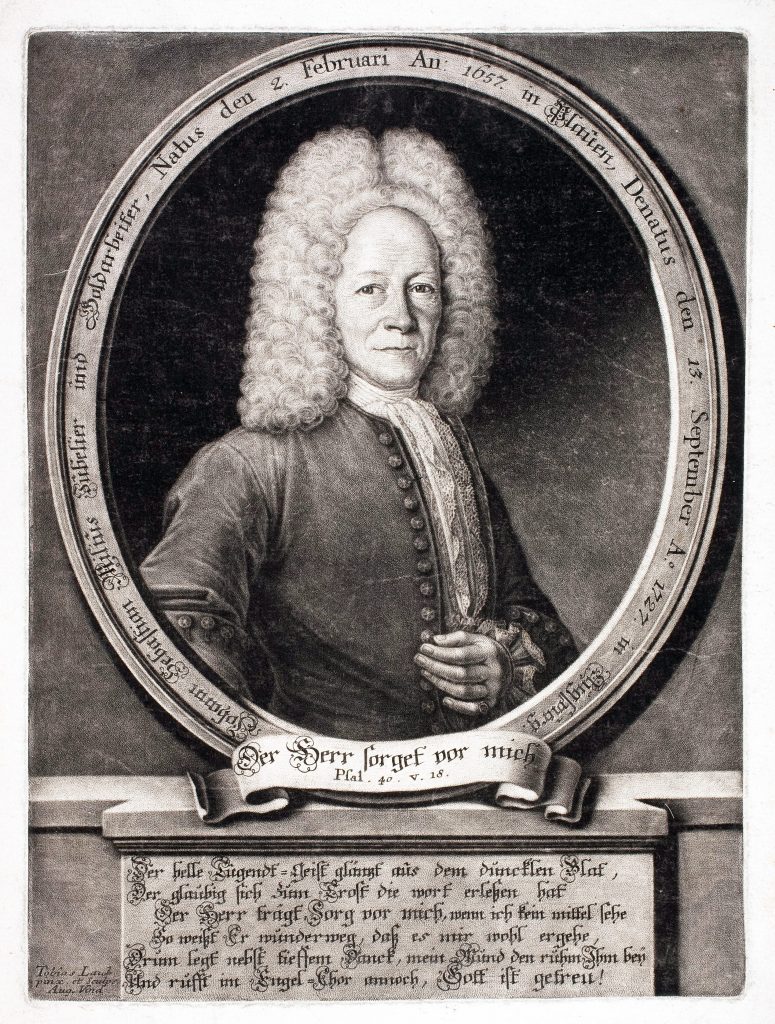

son of Johann Sebastian
Other sources say that as Lieutenant General Auditor, Christian Otto was the permanent representative of the Auditorium General in the king’s trial against Crown Prince Friedrich von Prussia and his friend Katte. He led the investigation and took part in the main hearing of the auditor. All of the originals in this criminal case come from the pen of General Auditor Lieutenant Mylius, the Prussian “Schönfelders” of his century. In 1739, a year before his death, Friedrich Wilhelm I appointed Christian Otto, then 61, as Auditor General of Brandenburg-Prussia. This made him the influential head of the military justice administration. In peacetime he belonged to the cabinet, in war to the king’s staff. He was allowed to present his views on all questions of the military administration of justice to him.
In the General German Biography, it goes on to say:
“Mylius was an experienced, insightful businessman and a thorough systematist, of which his two main works – two comprehensive collections of ordinances – bear testimony. As already mentioned, he began one of these immediately after settling in Halle in 1703 and completed it (1714) as the municipal syndic. The work, which had been put together with persistent diligence and great precision, bears the title (in part): Corpus Consitutionum Magdeburgicarum Novissimarum … . In it the author gives a collection of the lordly decrees for Magdeburg and its union with Kurbrandenburg (1680) up to his day (1714), arranged according to objects and time. Below …

Christian Otto’s cousin

A few years later (1717) this was followed by a continuation covering the period 1714-1717. The recognition that the carefully worked collection earned in professional circles encouraged the author to do a second volume of decrees. The government granted him a protective privilege for the publication of this work and instructed both the archives and the registries to send the publisher as exhaustive a copy as possible. So gradually the Corpus Consitutionum Marchicarum, or the Edicta, Ordnungs, Mandata, Resrcipta etc. along with a number of ‘continuations’ was created. The main work is dedicated to the King of Prussia (as shown above)
He retained the full use of his senses until the end of his days, and still worked in the last years of his glorious life, which he decided in January 1760 to exhaustion. Neither from his first or second marriage in 1751 with Christiana Rosina Bastineller, a sister of his previous wife, no children were conceived.
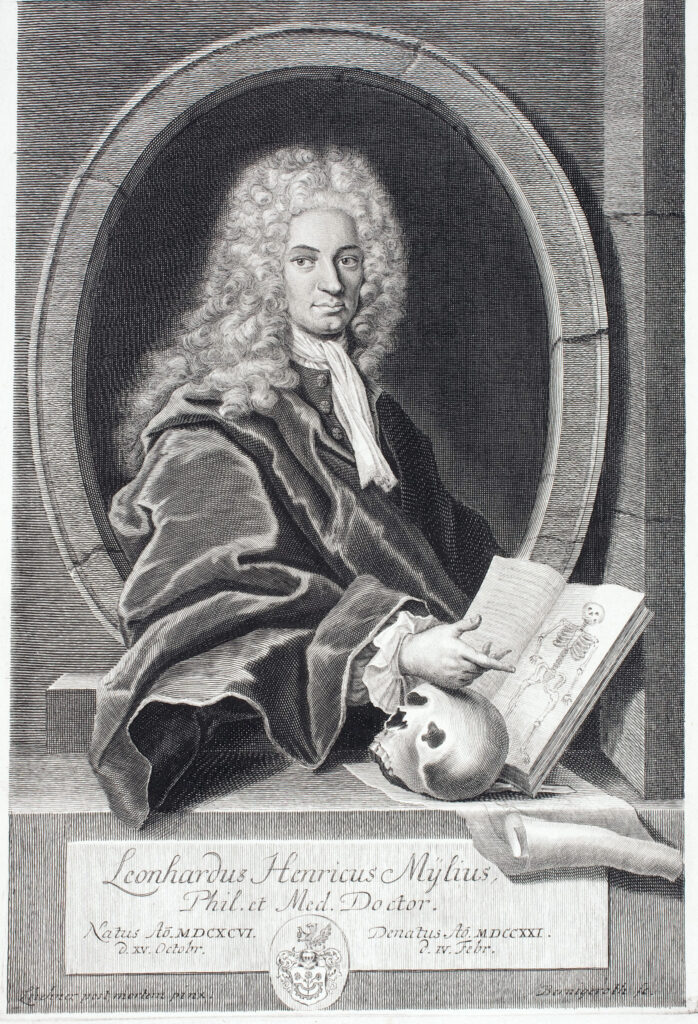
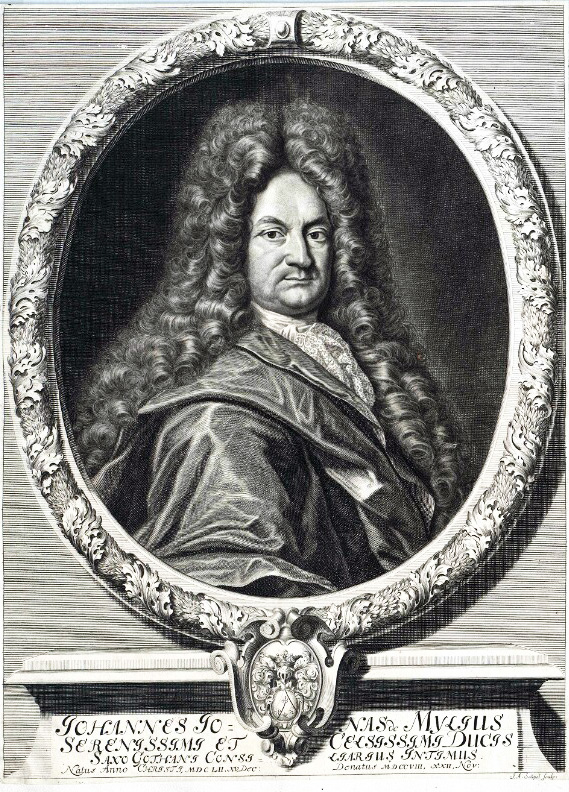
Caring for his relatives and good friends was one of his main duties; he did much good to the poor; He looked after the abandoned and orphans in a fatherly manner. When he sold his lucrative property in Diemnitz near Halle, he offered a capital, the interest of which the local preacher receives every time, and for which he has to give a sermon to the congregation every week during Lent. … In addition to his important official business, he was the adviser and arbitrator for many persons and families of status in their legal affairs inheritance rights.
The epitaph below was raised by the widow of Johann Balthasar Mylius (1654 – 1717) Johanna Margarethe von der Burg (1677 – 1760) – in honor of the memory of her first husband – Mylius – and her second Johann Friedrich Leucht. The inscription in Latin reads:
“To the men who did outstanding work for the city of Plauen, the famous Mr. Johann Balthasar Mylius and Johann Friedrich Leucht, one of whom on the right, born in Plauen on July 29, 1654, held the post of polygraph and syndic was established there for the first time, administered it most faithfully for 21 years, then wisely held the consulate of the city entrusted to him for a period of 11 years; lived in harmony with his wife Johanna Margaretha, daughter of Engelbert von der Burg, for 18 years and passed away on October 14, 1718 leaving them and three children behind. The other on the left was born on August 9, 1657 in Falkenstein, and in Plauen was in charge of the office of protonotary, which was confidently entrusted to him in 1696, of pro-consul in 1705 and consul in 1711 with the praise of the utmost seriousness. For almost two years he had the former’s wife as the most pleasant companion in life. Finally, on June 10, 1721, he breathed out his life without any offspring. Both, whose bones rest here in the grave under this temple, erected this monument as a sign of love and admiration for the wife of both and the children of the first. “

